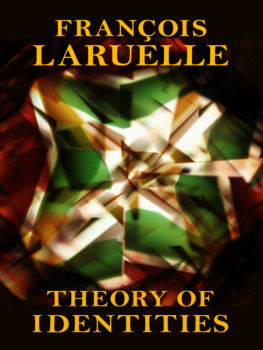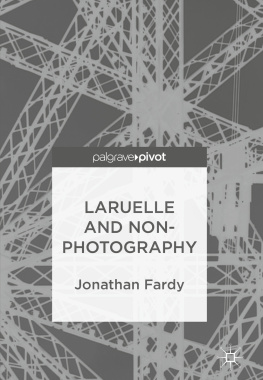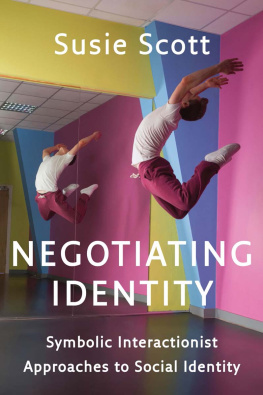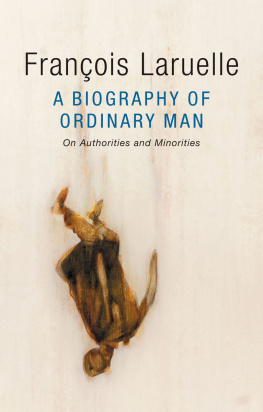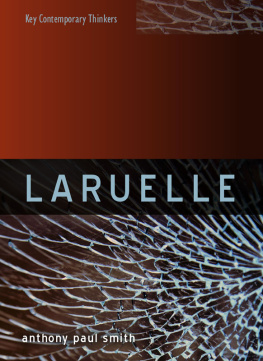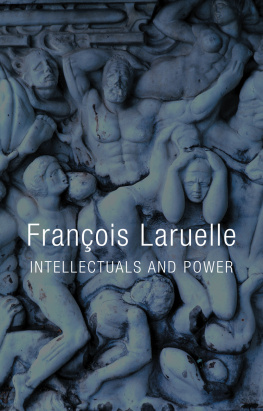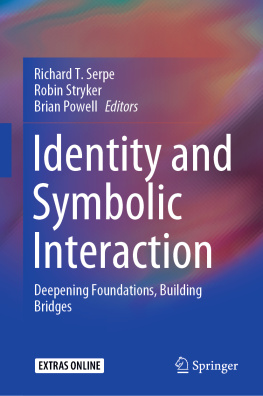Table of Contents
THEORY OF
IDENTITIES
FRANOIS
LARUELLE
THEORY OF
IDENTITIES
TRANSLATED BY ALYOSHA EDLEBI
COLUMBIA UNIVERSITY PRESS
NEW YORK
Columbia University Press
Publishers Since 1893
New York Chichester, West Sussex
cup.columbia.edu
Thorie des identits: Fractalit gnralise et philosophie artificielle copyright 1992 Presses Universitaires de France
Copyright 2016 Columbia University Press
All rights reserved
E-ISBN 978-0-231-54145-9
Cet ouvrage a bnfici du soutien des programmes daide la publication de lInstitut Franais.
This work, published as part of a program of aid for publication, received support from the Institut Franais.
Library of Congress Cataloging-in-Publication Data
Names: Laruelle, Franois, author.
Title: Theory of identities / Franois Laruelle; translated by Alyosha Edlebi.
Other titles: Thorie des identits. English Description: New York: Columbia University Press, 2016. | Includes bibliographical references and index.
Identifiers: LCCN 2015039843 | ISBN 9780231168946 (cloth: alk. paper) | ISBN 9780231541459 (e-book)
Subjects: LCSH: Philosophy. | SciencePhilosophy. | Identity (Philosophical concept)
Classification: LCC B77 .L3713 2016 | DDC 111/.82dc23
LC record available at http://lccn.loc.gov/2015039843
A Columbia University Press E-book.
CUP would be pleased to hear about your reading experience with this e-book at .
Cover design: Lisa Hamm
Cover image: Nigel Grima. Private Collection/Bridgeman Images
References to websites (URLs) were accurate at the time of writing. Neither the author nor Columbia University Press is responsible for URLs that may have expired or changed since the manuscript was prepared.
ambient with a grant
Figure Foundation
CONTENTS
RETROSPECTION (2014)
PHILOSOPHERS always present their undertaking with the seriousness of ferrets at work and usually without much humor. Saving their irony for the world or for their predecessors, they are more reluctant to take on their own fictions, their novels. And yet they dream. Plato and Nietzsche suggest that philosophers dream of the fumes of intoxication rather than of intoxication itself, of poetic inspiration rather than of poetry. In most cases, their dreams come very close to reality, lingering for a long time over concepts. But these reveries are philosophys matrix, its preparation or the lying-in-wait of its rationalization, the way Descartes presents his dreams in order to prepare the exposition of his cogito. Others, wide-awake, still fantasize about chaos, explosion, breakage, rupture, and collision, but also, and quite differently, tsunami or drowning, always like Descartes. These are the philosophers dreams within the limits of simple reason, according to Kant, that cold dreamer, one of the most humorous perhaps, who was surprised to find himself dreaming of Swedenborg.
As for us, it is time to sound the alarm and to clarify an ambiguous situation. We hesitate between two modes of classification grounded in the style of our object, a corpuscular mode earlier andgiven the final impossibility of maintaining this corpuscular distinction between stages or erasan undulatory mode now. Each of non-philosophys works contains all of this in an indivisible or holistic way. But even the division into stages or steps serves to mark doses or proportions, nuances and accents that should not be dogmatically isolated. Non-philosophy is a system of stages as much as of phases, of particles as much as of flows or waves. It is risky to prefer the classification by steps or stages and to fail to notice the waves that sweep them away and render every classification undecidable.
No doubt we too have dreamed. We dreamed of a joyous Iliad that left too hastily to look for its Odyssey, that believed it reached this Odyssey from time to time, and that wandered from shore to shore without ever finding solid ground, doomed to sink in the contemplation of immobile stars that the river Metaphysics carries along. Lets say immediately and clearly: non-philosophy is a dreamed philosophy, a reverie or a fiction that owes a great deal to a certain power of dreaming peculiar to music.
Theory of Identities is the book of the milieu, of the middle. Such is its situation, the one from which a balance sheet starts to become possible. It presents itself as a balance sheet in a doubly forced writingforced by the problematic results of the Philosophical Enterprise and by the crucial question: how can we continue with so weak a productivity? Lets think for a moment in terms of capitalist humor, i.e., in prosaic terms: philosophers have spent lavishly and imprudently, overindulged the zero unemployment, and consumed without restraint the abundance of materials. Lets have them work part time and experience a labor scarcity. Most of them do not worry about their means of subsistence; the decline of these means is not their problem. But what can existence and the whole of ontology do without means, if they are merely consumptive, i.e., if they simply reproduce their own sterility?
The works milieu, its middle, is a way of rejecting the system. And there are many possible rejections. Treated negatively as a caesura, the milieu determines a philosophys fairly rigid and definite order of exposition (Heidegger and Wittgenstein). This is, for us, the sure sign of a will-to-system and to-unity that failed. But it does not always divide in half a work that will be stitched and disjointed a thousand times by the interpreters. Treated more positively as a continuous milieu of existence, it does not exclude modalities, nuances, and accents. We began by practicing the care of the One against the care of Being, but we have also cut and recut a great deal in the classical concepts. The One has become the One-in-One, then the under-One, then Idempotence. The classical duality has become the unilateral duality or the complementarity. The ekstatic vector was divested of the double ekstasis and has become underekstasis, identity a nonidentity. Non-philosophy is a thought of the duality that began through a reclamation of the One rather than of Being. But the One founds a very different lineage (One-in-One, flux, duality, under-One, before-priority) from Beings (priority, difference, stases or stages or figures) and leads more reliably to duality than Being does, which aspires to the One and is satisfied with that aspiration. Under this complex form, Theory of Identities isafter Biography of the Ordinary Manthe retrospection on the construction of a philosophy, the central arc of a bridge open to the circulation between the first construction of non-philosophy and its current or nonstandard forms. It is the mise en tableau, the visual concentrate of a long caesura that shapes philosophys intimacy through sciences means and that appears here according to a vertical cut, which clearly shows what the battle between these two thoughts (science and philosophy) has been. In this sense it is a synoptic book, a systematic capitalization of acquired knowledge, a book that crosses once more the various possible paths within non-philosophy, as the digraphia of a balance sheet, recording the advances and retreats, at times lacking the balance and symmetry of later works. It brushes against the encyclopedia, without returning to Noahs arch of absolute knowing in which Hegel recollected history.

